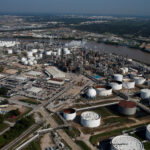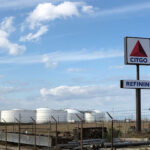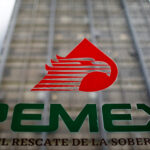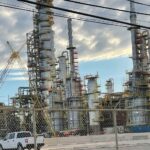Records 3Q production of 3.8 million boe/d, $2.7 billion earnings
The world’s largest publicly-traded oil company gave its 3Q 2016 earnings call this morning. Jeff Woodbury, Vice President of Investor Relations, was on the call while CEO Rex Tillerson was not present.
The company logged earnings of $2.7 billion, a 38% decline from 3Q 2015, as well as capital and exploration expenditures of $4.2 billion, a 45% decrease from the same period. The corporation distributed $3.1 billion in dividends at $0.75 per share, a 2.7% increase compared with the previous year.
Total production was 3.8 MMBoe/d, with liquids down 5.1% and natural gas up 0.8%. In its Permian and Bakken assets, the company ran a total of 10 rigs in the third quarter with combined production of 240,000 bl/d.
A slide showing major upstream projects coming online in 2016 to 2017 is shown below.

Reserves Impairment Outlook
Woodbury further commented on the impact that low commodity prices will potentially have on reserves valuations.
“The low-price environment impacted our 2015 reserves replacement resulting in a 67% replacement ratio. This was the net result of natural gas reserves being reduced by 834 million oil-equivalent barrels, primarily in the US, reflecting the change in natural gas prices offset by liquid additions of 1.9 billion barrels.”
“Given that year-to-date crude prices are down further from 2015 by almost 25% on the SEC pricing basis, we anticipate that certain quantities of currently booked reserves, such as those associated with our Canadian oil sands, will not qualified as crude reserves at year-end 2016.”
“In addition, if these price levels persist, reserves associated with end of field life production or certain other liquids and natural gas operations in North America also may not qualify. We do not expect the de-booking of reported reserves under the SEC definitions to affect operation of these assets or to alter our outlook for future production volumes.”
Key 3Q Events for the Upstream Business
- ExxonMobil and InterOil Corporation announced an agreed transaction worth more than $2.5 billion, under which ExxonMobil will acquire all of the outstanding shares of InterOil. The acquisition will give ExxonMobil access to InterOil’s resource base, which includes interests in six licenses in Papua New Guinea covering about four million acres. The transaction is pending the outcome of a shareholder appeal of the court decision approving the transaction.
- In Guyana, the Liza-3 appraisal well was successfully completed in October, confirming a resource discovery in excess of 1 billion oil-equivalent barrels. Also in October, the Owowo-3 exploration well, located offshore Nigeria, confirmed a discovery of 500 million to 1 billion barrels of oil.
A slide showing a current schedule of projects in the pipeline is shown below.

Analyst Q&A
During the Q&A session, the company answered questions on Capex allocations, potential U.S. shale acquisitions, macroeconomic fundamentals, chemicals demand, asset impairments, and the outlook for global LNG demand.
Q: Given the degree that CapEx is lower than you had guided, are you surprised by the degree of savings you’ve been able to achieve? And as we look ahead, where are we in this cycle of CapEx savings?
XOM: It’s trending towards an outlook of between $20 billion to $21 billion for the full year.
Q: What are you thinking about valuations in U.S. shale today?
XOM: We’re looking for opportunities that would create incremental value. These opportunities need to compete with our existing investment portfolio and provide accretive strategic long-term value to us.
Q: I know Rex had made some comments on London talking about a more subdued market over the next couple of years. Can you just talk about how you see the balances over the next couple of years, both from a supply and demand perspective?
XOM: Demand has been generally reasonably strong. I mean when you think about a 10-year average demand growth of somewhere between 1 million to 1.1 million barrels per day. Since 2014 we’ve seen demand growth in excess of that. So fairly reasonable demand growth in the recent past.
If you look, focus now on the first part of 2016, we still continue to be in an oversupply situation with production exceeding demand by about 1.1 million barrels a day in the first half. As we anticipated, we are seeing convergence in the second half. But I’ll tell you that as you continue to progress that, we’ll probably end up this year oversupplied by anywhere from a half million to 0.8 million barrels per day of supply. Now of course all this is going into commercial inventories. So as you move into 2017, you see that we continue to see convergence, maybe a little bit oversupplied in the year, but I’d caution that we’ve got to recognize that there’s still anywhere from 500 million to 600 million barrels of commercial inventory build since the end of 2013 that’s got to come out of inventory at some point. And then of course, there’s still uncertainties in the supply trend, some of the OPEC counties as well as the U.S. unconventionals, will have an influence on the supply and demand balance. So I think when you heard Rex’s comments, he was reflecting on all these factors as to how that will impact price in the near-to-medium term.
Q: Can you explain the rationale behind your new chemical complex in the Gulf? Is this due to liquids and other associated products coming out of your oil fields in the U.S. or is it just a separate economic decision?
XOM: Like most everything in Exxon Mobil, it all starts with our view on long-term energy supply and demand picture. And when you think about chemicals, the chemical demand growth based on our latest outlook has, from an overall perspective, chemicals growing about 1% above GDP; and from an ethylene perspective, we’re expecting that chemical demand will grow such that you add – need to add about 5 million tons per annum of new capacity per year. And to put that into hardware, that would be three to four world-scale crackers per year.
So that sets up the value proposition. First, as you know, we’re expanding the Baytown Complex to add another 1.5 million tons per annum of ethylene capacity, a corresponding investment at Mt. Bellevue adding derivative units to produce Exxon Mobil’s high-value metalycine and polyethylene. And then we announced, to your question, we announced a potential joint venture with SABIC to jointly own and operate a complex in the U.S. Gulf Coast that would notionally be an ethylene steam cracker to produce ethylene of about 1.8 million tons per annum and corresponding derivative units that would be built alongside that. I think we’re ahead of the game in terms of making some world-scale investments in this and a very strong component of our chemical business.
Q: Could you remind us what percent of your LNG volume is not under long-term contract? And given the slowdown in traditional Asian markets, particularly Japan, Korea and Taiwan, are you seeing more near-term opportunities in other regional markets? Do you have any incremental thoughts on European gas picture?
XOM: From our energy outlook we have gas growing about 1.6% and LNG growth just under three times where we are in current LNG capacity. As you go forward, our LNG business is a very important part of our portfolio. I don’t have a specific breakdown of our total gas production between pipeline sales and LNG contract sales, but recognize that a large part of our Asian gas coming from Cutter and Papua New Guinea is under long-term contracts and a good part of them are liquids-linked.
In terms of the markets, clearly the Asian-Pacific market is an important market for LNG. We’ve got a very expansive marketing organization to go and identify value opportunities. We are primarily interested in locking in long-term contracts, either a point-to-point or a portfolio sale. You may recall that before we take an LNG project to a final investment decision that we lock in a majority of those volumes in a long-term contract. We’ve really developed a very strong reputation and credibility with the buyers to our ability to deliver these projects on schedule, and our responsiveness to managing through the contract terms, we’ve got a new operation center that we put in place in Asia-Pacific to facilitate the transactions with our many buyers.
Q: With you effectively breaking even in the current environment, how should we think about how you managing additional cash flow into 2017 as the oil and gas price recovers? How do you prioritize an increase in activity levels versus growth and distributions versus reduction and leverage?
XOM: From our cash flow from operations, the first thing that the Corporation wants to do is go ahead and pay a reliable and growing dividend. The next thing is the remaining cash is put towards through to an investment program that has gotten to the point where we believe that we have maximized the value proposition for investment. If we’ve got enough cash to go ahead and invest it to fund that investment program, then the remaining cash we’ll either put forward to either stock buyback, share buybacks, or paying down our debt. If we don’t have enough cash, as you’ve seen us do in the recent past, is we’ll go ahead and further leverage our very solid balance sheet and debt capacity to take on some additional debt because the service costs associated with that debt is more than benefited by the return we get from these investments. So it’s important to recognize that while we are very mindful of prudently managing our cash, we also believe it’s very important for us to continue to invest through the cycle and we do that in a very measured way that we’re not leaving any value on the table. Therefore, my comments I made earlier about making sure that we’re optimizing value in the bottom of a cycle.
Q: Question with regards to the way you look at your asset impairments versus the way that you look at acquisitions. Just trying to square the fact that you haven’t written down assets in 2015, given you’ve got, I suppose, a fairly constructive view on commodity prices with the kind of the opposing fact that you haven’t done a deal over the last year or so, given that you haven’t seen attractive enough assets in the market. Can you just talk about how those two things work together?
XOM: There’s two separate processes. Our asset management activity is a function of making sure that we are capturing opportunities, as I said earlier, that are competitive to our existing portfolio. The objective here is making sure that we’re growing shareholder value. And if we think that we can acquire an asset like the InterOil transaction that we can add incremental long-term value, then we’ll go ahead and pursue those type of opportunities. Our determination of asset impairment is a comprehensive process that we follow. And, as I said, it’s detailed in our 2015 10-K and it’s a separate process. It’s not informing or influencing our asset management activity.
Links to Exxon’s 3Q 2016 earnings release, presentation, and webcast are provided.







